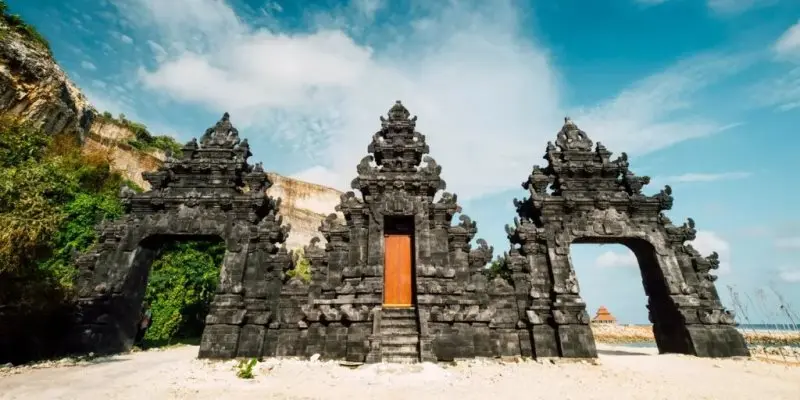Indonesia, an archipelago of over 17,000 islands, is a land of unparalleled natural beauty and cultural diversity. Among its many treasures, Indonesia boasts a remarkable collection of ancient temples that stand as testaments to its rich history and spiritual heritage. These temples, scattered across the sprawling archipelago, offer travelers a mystical journey back in time to explore the wonders of ancient Indonesian civilization.
In this article, we will embark on a virtual tour of some of Indonesia’s most captivating temples. From the grandeur of Borobudur to the enigmatic Prambanan, we will delve into the history, architecture, and spirituality that make these temples truly awe-inspiring.
Borobudur: The Jewel of Java
Nestled on the island of Java, Borobudur is often regarded as one of the world’s most impressive Buddhist monuments. Built during the 9th century, this massive stone temple is a marvel of engineering and religious symbolism. Borobudur comprises nine stacked platforms, crowned by a central dome, and adorned with over 2,600 relief panels and 500 Buddha statues. The temple’s design reflects the Buddhist concept of enlightenment, and climbing its terraces represents a spiritual journey towards Nirvana.
Borobudur has a magnetic pull for both tourists and pilgrims alike. The sunrise view from its uppermost platform is legendary and offers an otherworldly experience as the first rays of the sun illuminate the surrounding landscapes.
Prambanan: The Hindu Masterpiece
Located in close proximity to Borobudur, Prambanan stands as Indonesia’s largest Hindu temple complex. This 9th-century marvel showcases the architectural and artistic prowess of the ancient Mataram Kingdom. Dedicated to the Hindu trinity of Brahma, Vishnu, and Shiva, Prambanan features towering spires, intricate bas-reliefs, and numerous smaller temples within its compound.
One of the most intriguing aspects of Prambanan is its intertwining of mythology and history. The epic Ramayana is depicted through finely carved reliefs on the temple walls, recounting the heroic tale of Rama’s quest to rescue his wife Sita from the demon king Ravana. During the annual Ramayana ballet performance, the temple’s surroundings come alive with music and dance, creating an enchanting atmosphere for visitors.
Uluwatu: Bali’s Clifftop Gem
While Bali is primarily known for its pristine beaches, the island also hosts several temples of great cultural significance, with Uluwatu being a standout example. Perched atop a dramatic limestone cliff on the southwestern tip of Bali, Uluwatu Temple, also known as Pura Luhur Uluwatu, offers a breathtaking panorama of the Indian Ocean. This sacred sea temple is dedicated to Sang Hyang Widhi Wasa, the supreme god in Balinese Hinduism.
Uluwatu’s charismatic setting adds a mystical aura to the temple visit. Visitors can witness traditional Kecak dance performances against the backdrop of the setting sun, a spectacle that merges the rhythmic chanting of the performers with the temple’s captivating surroundings.
Candi Sukuh: The Enigmatic Pyramid
Deep within the lush jungles of Central Java lies Candi Sukuh, a peculiar and enigmatic temple that stands apart from the more well-known temples of Indonesia. Often referred to as the “Pyramid Temple,” Candi Sukuh’s architecture is reminiscent of Mayan ziggurats and includes mysterious erotic carvings and fertility symbols.
The purpose and origins of Candi Sukuh remain shrouded in mystery, sparking fascination and intrigue among archaeologists and tourists alike. Some believe it to be a site of ancient Javanese fertility rituals, while others associate it with esoteric and mystical practices.
Tanah Lot: The Ocean Temple
On the southwestern coast of Bali, Tanah Lot is another iconic temple that combines spirituality with breathtaking natural beauty. Perched on a rock formation in the Indian Ocean, Tanah Lot is dedicated to the sea god, Dewa Baruna.
Visiting Tanah Lot during high tide creates an illusion of the temple floating on the ocean, adding to its allure. Pilgrims and tourists gather here to witness the mesmerizing sunsets and experience a sense of deep connection with nature and the divine.
Conclusion
The temples of Indonesia are not just architectural marvels; they are living monuments that resonate with history, spirituality, and culture. Each temple tells a unique story of Indonesia’s past, its deep-rooted religious traditions, and its artistic ingenuity. Whether you seek enlightenment, cultural exploration, or simply a profound connection with the past, the temples of Indonesia offer mystical journeys to ancient wonders that are nothing short of awe-inspiring. So, pack your bags, set your compass, and embark on a voyage through Indonesia’s spiritual and historical heritage – a journey you will cherish for a lifetime.

